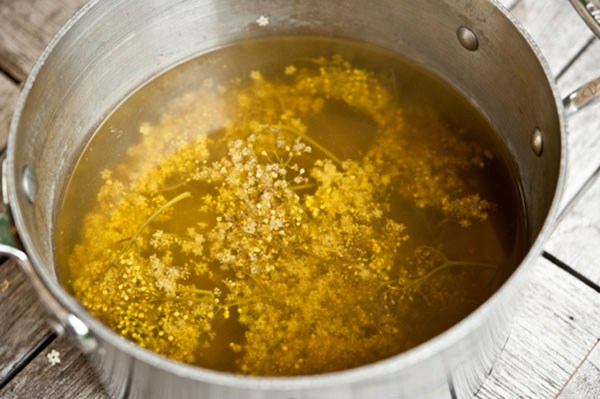The simple things in life are the ones that bring us the most pleasure, time and time again.
Walking my girls home from school this week, we harvested a big basket full of elderflowers from a bush that appeared to have been conveniently knocked close to the ground by a bear.
Elderflowers grow in small, white, cone-shaped bunches at the tips of its bush or tree (some can get quite big) and typically aren’t the easiest to reach without a ladder. The flowers are pure May gold, and when you steep them with simple syrup and lemon, you can create the most delicious and aromatic nectar. However, they do have a rather pungent smell in the process, so if you’re game, be prepared to do this on a day when you can open the windows.
The syrup can be enjoyed many ways, in a spritzer or just with water, over pancakes, and even in a cocktail. You can also serve it on top of fresh fruit, ice cream and yogurt, or add a teaspoon to whipping cream for a delicate flavour.
Our recipe takes about 30 minutes to prepare and 20 minutes to cook, and will yield about two litres of syrup — sufficient for a first time, but you’ll want to make more. I guarantee it.
You’ll need about 20 to 25 florets of elderflower, one litre of water, 1 kilo of sugar, and the zest and juice of about four lemons (discarding the bitter white pith).
After you’ve rinsed off the flower bunches and shaken them to get rid of any bugs or dirt, take off as much of the green — which in large amounts can be toxic — as possible and using only the small flowers in your ceramic bowl, add the lemon juice and zest.
In a separate pot, bring the sugar and water to a boil, stirring to dissolve the sugar. Once the sugar has completely dissolved, pour the hot syrup over the elderflowers and lemon and mix well.
Now you can cover the bowl with a towel and leave it at room temperature for two to five days.
Next strain the elderflower syrup through a sieve or colander lined with cheesecloth or muslin, and transfer to glass jars or bottles. We always heat process several for longer keeping. If not canned, the syrup will keep for about four weeks in the fridge.
In our family, making elderflower syrup has become an annual ritual we all look forward to. I love, in particular, how it connects my children with the natural world. Our girls mark the changes of spring themselves now: first with the blooming forsythias, then with the explosion of cherry blossoms, and now with the busyness of picking elderflowers and making syrup in the kitchen. Their connection to the Earth — and how it provides for us — is overt and beautiful.
Kirsten Andrews offers Simplicity Parenting courses, workshops and private consultations in the Corridor and Lower Mainland. Visit Sea To Sky Simplicity Parenting on Facebook or www.SeaToSkySimplicityParenting.com.



